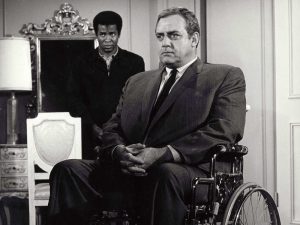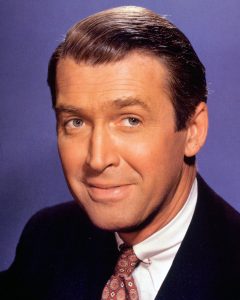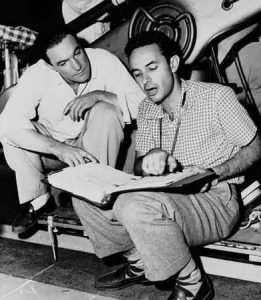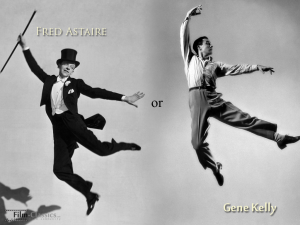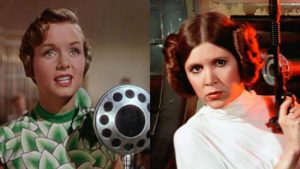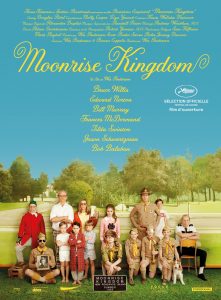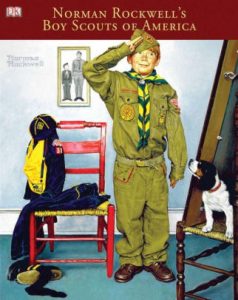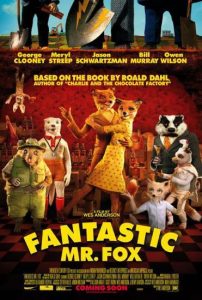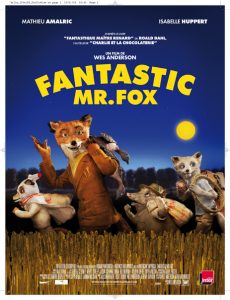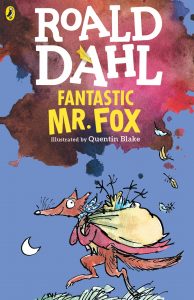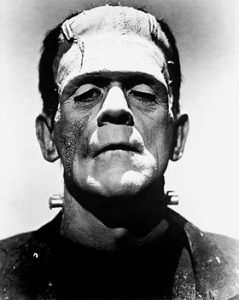REAR WINDOW
WHO’S WHO?
Raymond Burr, the bad guy.
http://www.elllo.org/english/Mixer026/T041-NewsSource.htm
James Stewart, the forever good guy!
He made 4 films with Hitchcock, The Rope, Rear Window, The Man Who Knew Too Much and Vertigo.
Grace Kelly. She was from a wealthy (= rich) family and she only did 3 films with Hitchcock (who loved platine blonde women) yet they are often considered as the finest in her career: Dial M for Murder, Rear Window and To Catch a Thief.
She finally married Prince Rainier of Monaco so she had to stop her career as an actress. She died in a tragic car accident.
Detective Lt Thomas J. Doyle. What does his name make you think of? 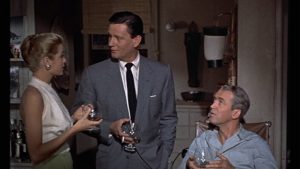
Hitchcock’s manipulation, a good analyze HERE.
The set. Where does the action take place?
The action takes place in Greenwich Village, a famous area in Manhattan, New York city. The set was 56 meters long with 36 furnished apartments, 1000 lamps and 2000 spotlights.
This film was the most expensive closed-door affair ever shot!
LE PROLOGUE
La caméra se charge de tout dire. Il n’y a aucun dialogue mais en quatre plans, Hitchcock dit tout.
Plan 1. Générique et lever de rideau qui révèle le petit théâtre privé du héros, Jeff. A la fin du plan, la caméra passe par la fenêtre, comme une annonce de la scène finale…
Plan 2. On suit un chat… pour le moment, on ne sait toujours pas qui regarde… fin sur Jeff.
Plan 3. 90° F = 34° C. Idée de chaleur qui peut donner des hallucinations.
Plan 4. Fonction sociologique et psychologique. On assiste au réveil d’un quartier populaire. Le spectateur est déjà coupable de voyeurisme avant même que Jeff s’en passionne. La caméra produit ensuite seule la caractérisation du personnage. ‘Voir, c’est savoir’. Il est plus intéressant de découvrir les détails de cette façon plutôt que si un personnage demandait à Jeff ce qui lui était arrivé.
Ce prologue est virtuose. Tout est dit en 4 plans. Ce que permet cette fenêtre: le permis / l’interdit et la limite du cadre.
La télévision
Avènement de la TV comme média de masse. En 1950, il y a 4 millions de postes et en 1954, on est passé à 20 millions. Parallèlement, en 1943 on compte 8 millions d’entrées au cinéma. En 1954 on est passé à 4 millions. Jeff n’a pas de TV chez lui. Pour lui, sa fenêtre est la lucarne.
SINGIN’ IN THE RAIN
POSTERS AND TRAILER
Look at the different posters. What can you imagine about the film? What kind of film is it? (genre).
Watch the trailer and comment.
THE ACTORS
He is Stanley Donen’s friend.
He is a great dancer too! He was in competition with Fred Astaire.
Who is Debbie Reynolds?
She is Carrie Fisher’s mother! Carrie Fisher is Princess Leia in Star Wars!
THE STORY
The film is about the transition from silent films to ‘talkies’ or films with sound. This is a famous silent film by Charlie Chaplin, The Kid.
Now let’s have a look at the first sound film, The Jazz Singer.
EVERYTHING USEFUL TO KNOW ABOUT HITCHCOCK
This video was made to illustrate a radio interview by Colin Edwards from the http://PacificaRadioArchives.org
« The master of suspense, Alfred Hitchcock, sat down for a short interview on the set of a film tentatively titled, From Amongst The Dead. The film would be released in early 1958 as Vertigo, the classic starring Jimmy Stewart and Kim Novak. In this interview, we go inside the mind of a master storyteller with a penchant for fear. »
This short video-essay examines various themes and techniques Alfred Hitchcock developed throughout his career. Using 40 titles, it includes every feature film Hitchcock made from 1934 right through to his retirement in 1976. Of the several themes on display here (falling, ascending and descending staircases, opening curtains, reading newspapers, poisoning drinks, women’s hairstyles, shoes, train compartments, sleeping and dreaming, pulling away from and dollying in on the action, overhead shots and characters looking directly into the camera), there are yet others for fellow essayists to examine further (looking through and climbing in and out of windows, nuns and clergymen, eating food, kissing in the countryside, women wearing glasses and people playing games such as tennis, hide-and-seek, fancy-dress and blindman’s bluff).
Hitchcock’s famous cameos, the article HERE or THERE.
English film director Alfred Hitchcock made cameo appearances in 39 of his 52 surviving major films. For the films in which he appeared, he would be seen for a brief moment in a non-speaking part as an extra, such as boarding a bus, crossing in front of a building, standing in an apartment across the courtyard, or even appearing in a newspaper photograph.
This playful gesture became one of Hitchcock’s signatures; and fans would make a sport of trying to spot his cameos. His appearances became so popular that he began to make them earlier in his films so as not to distract the audience from the plot. Hitchcock confirms this in extended interviews with François Truffaut, and indeed the majority of his appearances occur within the first half-hour of his films, with over half in the first 15 minutes.
Look at the video to check all his cameos.
The art of title sequences HERE.
And THERE.
HITCHCOCK ressources
MOONRISE KINGDOM AFTER THE FILM
SENS DE LA NOSTALGIE
aspect vintage et pop culture par tenues, musique des années 70. Importance de l’élégance qui n’est jamais vaine, du chic. Les détails participent à la mélancolie.
nostalgie de l’enfance
ENFANCE et CONTE INITIATIQUE
Les adultes ne tiennent pas le bon rôle, ils mentent (adultère, parents dysfonctionnels ou démissionnaires), ils n’aiment pas leurs enfants. Ils se rachètent à la fin.
Les enfants souffrent de l’abandon des parents. Il règne une violence exercée sur les enfants. Les personnages se comportent mal envers les enfants, ils sont méchants.
L’enfance c’est l’âge d’or mais il y a tj cette nostalgie, mélancolie. Leur vie est malheureuse.
Le triomphe des losers! rapport à l’échec. Losers de génie > Mr Fox, Sam… échec social, scolaire.
Goût obsessionnel pour la lecture dans laquelle les enfants s’enferment.
Les rôles sont inversés: les adultes réagissent comme des enfants et les enfants pensent en adultes.
LA BANDE SON
La musique n’est pas utilisée seulement de façon illustrative, elle sert le propos, elle rythme l’action, jeu avec les paroles.
FRONTALITE THEATRALE
Nous sommes au théâtre! Frontalité de tous les plans! Wes Anderson a l’obsession du détail. Un plan est très bien étudié et traité à part entière.
Les plans sont symétriques. Il aime les mises en abyme.
Rien ne vient du monde réel, tout est artificiel (depuis le second plan de l’affiche du film!). Les décors sont faux. On réfléchit au processus de création, à la fabrication des films, dans un univers clos. Ce monde clos est imaginaire, lié à l’enfance.
La violence occupe une part importante mais est montrée avec distance (cf la mort du chien).
Imaginaire de l’enfance et découverte d’un territoire mythique = imaginaire de l’Amérique des pionniers et des scouts!
HAPPY END
Importance du Happy End, tout rentre dans l’ordre, les enfants suivent le moule des adultes!
More about his technique HERE. Images and no comments.
MOONRISE KINGDOM
BEFORE THE FILM
1. Look at the poster of the film.
What kind of film is it? What can you imagine about the film?
What do you think of the title?
Compare the French version with the American one. What differences can you find?
Now watch the trailer HERE.
2. Who is Wes Anderson, the director?
He is an American director. He was born in 1969 in Houston, Texas. He looks like a dandy. He usually wears suits and he deeply loves the yellow colour that you can find in all his films!
You can learn more about his style watching some memorable advertisements he has directed HERE.
He’s particularly fond of families, animals, childhood, painting, writing, books and letters.
3. The script and the aesthetics.
Which period of time do the costumes and the scenery make you think of?
What is the meaning of ‘Pop Culture’? And ‘vintage’?
We usually mean an old item, which carries certain nostalgic value, and potentially is of high quality. It normally means something that is at least 20 years old, but not more than a 100, as then it would be classified as antique.
Think about the link between Noah’s ark and the Flood and the storm coming on the island.
4. The technique.
Wes Anderson et son chef opérateur, Robert Yeoman, composent la majorité des cadrages selon des règles géométriques strictes.
Les horizontales et les verticales sont mises en valeur par leur parallélisme avec les bords de l’image ; les personnages et les objets sont souvent saisis de face, au centre. Mais il n’y a pas que la composition des images qui produit cette rigueur géométrique. La mise en scène des personnages et des objets, les détails des costumes ou des décors à l’intérieur des images, suivent les mêmes règles. Considérons l’horizontale. Relever toutes les manières dont sont construits des alignements, des enfilades ou des ribambelles (file indienne de corps, utilisation de cordes tirées, accentuation des horizons, mouvements latéraux de la caméra) est un exercice qui peut être fait de mémoire, après la vision du film. Vous remarquerez que le procédé se répète, sans jamais produire des images identiques. Tout en donnant le sentiment d’être obsessionnelle, la mise en scène de Wes Anderson est constamment inventive.
5. The music
Music is very important to him.
Music by British composer Benjamin Britten plays a surprisingly prominent role in Moonrise Kingdom.
The film’s duo protagonists, 12-year-olds Sam and Suzy, first meet at a rehearsal for a production of Britten’s Noye’s Fludde (Noah’s Flood) — and this opera written for a mix of professionals and amateurs proves integral to the film’s plot.
Anderson performed in Noye’s Fludde himself when he was 10 or 11 years old. He says he’s been humming « these hymns and things from that play/opera all my life. »
And there’s something about Britten’s « children’s music » that appeals pretty directly to Anderson’s sensibilities as an auteur. As the filmmaker observes, they are « classical pieces that are meant to have an audience of children, but are not written down to children — they’re meant to educate children in what classical music really is. Britten seemed really motivated by that. » (No surprise that Britten’s The Young Person’s Guide to the Orchestra, narrated conducted by Leonard Bernstein, also makes a cameo in Moonrise Kingdom.)
It’s also pretty fun to develop theories about the significance of Britten’s music in Anderson’s film. That is to say:
- Britten’s opera Peter Grimes takes place in an insular seaside village on England’s east coast. Moonrise Kingdom takes place in an insular seaside village on New Penzance, an imaginary island off the coast of New England.
- Grimes: a terrible storm. Moonrise Kingdom: a terrible storm.
- Grimes: in Britten’s words, an opera about « the struggle of the individual against the masses. » Moonrise Kingdom: nearly everybody struggles, with the possible exception of Social Services (Tilda Swinton).
- Britten’s opera Billy Budd: major cruelty in the British navy. Moonrise Kingdom: sadistic machinations amongst Khaki Scouts.
Here‘s pretty much every song used in a Wes Anderson film.
6. His sources of inspiration.
Do you know Norman Rockwell?
Norman Percevel Rockwell (February 3, 1894 – November 8, 1978) was an American author, painter and illustrator. His works have a broad popular appeal in the United States for their reflection of American culture, the American way of life. Rockwell is most famous for the cover illustrations of everyday life he created for The Saturday Evening Post magazine over nearly five decades.
L’Amérique mythologique n’existe que dans ses dessins! Vision idéale de la famille, des scouts… un idéal des années 50. Il parle de l’Amérique des pionniers, idéal des origines.
He is also noted for his 64-year relationship with the Boy Scouts of America (BSA), during which he produced covers for their publication Boys’ Life, calendars, and other illustrations.
FANTASTIC Mr FOX
BEFORE THE FILM
1. Look at the poster of the film. What kind of film is it? What can you imagine about the film?
Combien de personnages vois-tu? A quelles espèces appartiennent-ils?
Que peux-tu dire de leur attitude? Comment sont-ils positionnés les uns par rapport aux autres? Quel personnage ressort et pourquoi? Quels éléments textuels ressortent? Quelles informations donnent-ils?
Now watch the trailer HERE.
2. Who is Wes Anderson, the director? He is an American director. He was born in 1969 in Houston, Texas.
3. This film is adapted from a book, by Roald Dahl.
Wes Anderson a dit en interview qu’il s’agissait du 1er livre qu’il avait lu.
You can read the beginning of the book HERE.
Do you know this writer? What other book can you name?
4. The technique – stop motion
What is it? HERE.
It is different from a cartoon. Do you know other films in stop motion?
Wes Anderson found his inspiration in this film HERE.
Une fois le scénario écrit, Anderson a contacté Henry Selick – réalisateur de L’Étrange Noël de Monsieur Jack (1993), James et la Pêche géante (1996) – pour qu’il tourne Mr Fox en stop-motion (animation image par image). Mais Selick étant déjà occupé par son propre film Coraline (2009), Anderson a décidé de se familiariser avec la technique de l’animation pour mettre lui-même en image son scénario. 150 décors à échelle réduite, 4 000 accessoires sur mesure et 500 modèles différents de marionnettes ont été créés. L’herbe est une serviette-éponge, l’eau, du papier d’emballage cellophane, le feu du savon gélatineux orange et la cascade un film plastique alimentaire. 5 229 plans et 621 450 photos ont été enregistrés !
5. Analyse d’une adaptation
Connais-tu d’autres auteurs qui utilisent les animaux pour parler de la société des hommes?
Fantastic Mr. Fox (publié en 1970, édité en France sous le titre de
Fantastique Maître Renard) est un des nombreux best-sellers que
l’écrivain gallois Roald Dahl a écrits pour les enfants.
Son schéma narratif est d’une simplicité extrême : il se construit sur l’opposition manichéenne entre trois fermiers aux traits grotesques et un renard particulièrement ingénieux. Le roman commence quand les premiers décident d’éliminer le second pour mettre fin à ses chapardages. Il raconte le combat acharné entre les deux parties, qui va subir de chapitre en chapitre une constante surenchère. Il mêle la farce (les fermiers, tournés en ridicule) et l’aventure (la lutte de Maître Renard pour sauver sa famille). Le jeune lecteur est invité à s’identifier à la figure héroïque du renard et à se projeter dans la cellule familiale qu’il forme avec Dame Renard et les renardeaux.
D’un point de vue formel, Fantastic Mr. Fox respecte fidèlement ce schéma : reprenant littéralement la quasi totalité des péripéties du roman, il intègre également une bonne partie de ses dialogues, et même certains titres de chapitres (« Mr. Fox a un plan »).
Mais le film de Wes Anderson investit les silences et les nondits du roman, l’enrichissant de nouveaux épisodes, lui ajoutant un prologue et un -long- épilogue (le roman s’arrête au festin souterrain des animaux), développant les personnages existants (les renardeaux Ash et Kristofferson, le blaireau, le rat) voire en inventant de toutes pièces (Kylie l’oppossum). Et il développe substantiellement la figure du héros, le Fantastic Mr. Fox, qu’il dote d’une complexité que n’avait pas le héros de Roald Dahl.
EDWARD SCISSORHANDS after the film
1. Is Edward human or not? Give elements that make him look like a robot:
- his costume
- he doesn’t grow old
2. Remember the colours. What can you say about the little suburb and the castle?
3. References to famous myths.
It also makes us think of fairy tales like Beauty and the Beast. Look at Jean Cocteau’s version (1946).
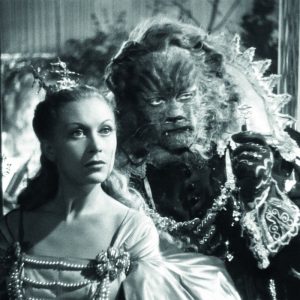
What are the differences in the love stories? At the beginning of both stories, the girl is afraid and then she finally falls in love with the Beast or the monster. But in Beauty and the Beast, there is a happy end because the Beast is turned into a prince and they can get married.
On the contrary, Edward can’t love Kim and they don’t finish their lives together. They are separated. Edward finishes his life lonely. Love is impossible!
4. The story is a long flashback.
Once upon a time, a great inventor…
Finally, that’s why it is snowing sometimes in California!
Ressources HERE… and THERE.
Tim Burton en 5mn ICI.
Encore ICI.
Ou ICI.
